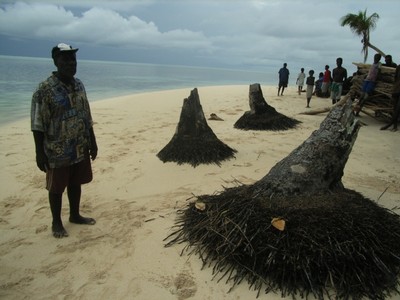The people of the Carteret Islands are about to make history, as they begin to leave their island to find a new home. Rising seas are making their atoll uninhabitable making land too salty to grow food and by gradually wasing the beaches on the small, sandy isalnds. When a suaitable home can be found they will start to leave. They are getting by now with the help of shipments of free rice from the Autonamous government of Bougainville.
“The sea is coming in very fast. Just beyond where you can see that tree trunk [pointing into the ocean] is where the sea shore used to be.” says Bernard Tunim, chief of Piul Island in Carterets.
“Just last month we had a high tide that swept over the whole area. We had waves coming from three sides, and so this place [a crop garden] was flooded with sea water. All we had – from banana to taro to cassava – just dried up. But we don’t want to move because this is our land.”
“We are frustrated and we are angry at the same time because we are victims of something we are not responsible for. We believe that these islands are ours and our future generations should not have to leave.”
Rafina Moi, elder woman from Han Island talks about the changes to the Carterets: “When I was a small girl the island was not like that. Today I see so many changes because the sea has washed away a big part of this island. It’s now very hard for the people because of the shortage of food. I think that the sea here is eating away the ground. In future years there may be nothing left unless experts can build sea walls that can help stop the erosion of the island, then maybe the islanders can stay.”
Part of Papua New Guinea, the Carteret Islands (also known as Carteret Atoll, Tulun or the Kilinailau Islands) are located 86 kilometres north east of Bougainville in the Pacific Ocean. The scattering of low lying islands stretches around a lagoon in a horseshoe shape running approximately 30 kilometers from north to south. With a total land area of 0.6 square kilometers and a maximum elevation of 1.5 meters above sea level, the Carterets have a population of around 2500.
All the islands have tree cover except where small clearings have been made for crop gardens. As the climate has changed and sea levels have risen, saltwater intrusion has occurred eating away at the land and poisoning crops. Natural variation in the islands’ elevation has exacerbated the problem increasing the Carterets’ vulnerability to climate change induced sea-level rise.
It was widely reported in November 2005 that the islands have progressively become uninhabitable. The islanders have battled for more than twenty years against the rising ocean, building sea walls and planting mangroves. However, storm surges and high tides continue to wash away homes, destroy vegetable gardens and contaminate fresh water supplies. On November 24, 2005, the Papua New Guinean government authorized the evacuation of the islands, ten families at a time, to Bougainville. The evacuation is expected to begin by 2008 and could continue up until 2020. It is estimated that by 2015, the Carteret Islands could be largely submerged and entirely uninhabitable.
The Papua New Guinean government has provided some funds for the relocation, but poor relations between Papua New Guinean government and the autonomous Bougainville government could hamper sufficient government resourcing for the relocation. In past years, many Carteret islanders have moved between their islands and the mainland of Bougainville, however civil unrest in Bougainville has meant that many islanders do not feel safe on the mainland and wish to remain on their islands.
Collated from the research and interviews of Pip Star, by Steph Long, Friends of the Earth Australia




